Our goal as surface designers is to see our products out in the world, making it a happier place with our art. That’s why we reach out to art directors to get a licensing deal. This is hard work and may take a long time. Licensing is not the only way to see your designs on products though. Have you ever considered creating your own products or product line? I truly want to be honest — it’s not any less work or time-consuming than licensing, but in a very different way. If you ever played with the idea of making your own products, read on and find out about my thoughts and experiences.
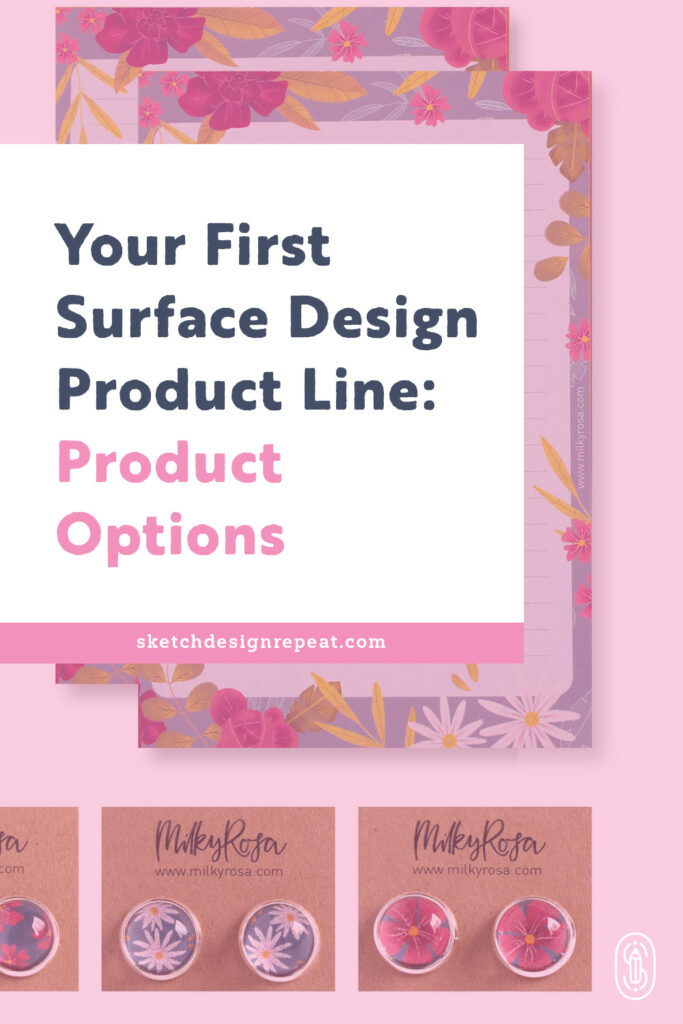
Why Should You Start Your Own Product Line?
Satisfaction
Making my own products always felt very rewarding. Having personal contact with buyers is one of the best things in my opinion. During an in-person show I can hear their Ooh’s and Ah’s while they look at my creations and hearing them compliment my style feels amazing. It really boosts your self-esteem! When you sell online you might not have this close relationship with your customers. But seeing a return customer pop up for another purchase or seeing them leaving you a note or reaching out to you on social media because they loved your product is a feeling I still can’t describe — and a serotonin boost.
Stream of income
When I started my part-time business in 2018, I only earned money through my product line. It wasn’t much, but it was additional money earned next to my full-time job as a graphic and interior designer. In 2021 I transitioned into doing art and design as a full-time career. That’s why there is a big jump in revenue from 2020 to 2021. During covid, selling my products was a bit of a struggle, because there were almost no in-person markets. But I could still rely on my graphic design clients. That’s why multiple streams of income are great. If one currently doesn’t work as well, you have another fail-safe to fall back onto. If I ever have a bit of a slow patch designing for clients now, I can jump into production mode to substitute my income with my products. Now about a third of my income is generated through merchandise sales.
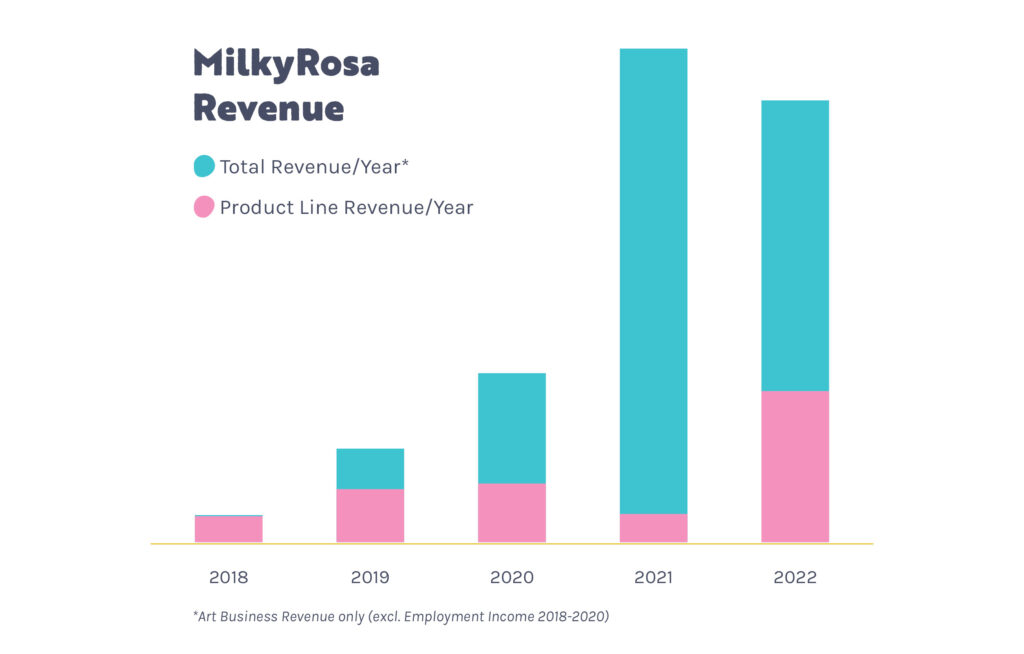
Control
If you are very particular about the look and feel of your products, this might be a reason for you to create your own product line. Because you are the one who decides every little detail. You are your own designer, art director, and quality inspector.
Direct buyer feedback
When licensing or selling through retail stores you only have one link between you and the buyers — the art director or purchasing department you are working with. Your only feedback might be them working with you again or them wanting to extend the license. But if you’d like more direct feedback, having your own product line can help you with it. Customers will start to buy your products and you’ll see which products are in demand the most. That’s why I like to test the waters by making smaller quantities first. This helps me to figure out which items and designs resonate with my clients. Just because I love an item, doesn’t mean they equally share my love for it.
USP
Have you ever wanted to have a brand? Selling your goods for a longer period of time will help clients recognize your signature style and products. If you make products with designs that are exclusive to your product line, you’ll strengthen your USP (unique selling point). It means that if your client wants your product because of the design, there is no one else out there who will sell it to him.
Related Article: Developing a Product Line
and How it Helps for Art Licensing
Possible Products to Offer as a Surface Designer
Picking the best products for you and your business depends on many different factors. Will you make them yourself or do you plan on getting them manufactured? Do you have any storage available? Would you like to be in charge of shipping or work through a POD site?
Below I want to kickstart your idea process. These are just a handful of possibilities. Make sure to keep your eyes open and write down any products you come across that you enjoy yourself that could be a possibility for your own line of products.

High-risk vs. low-risk items
High-risk items are products that require a high up-front investment or have an expiration date, like large bags or calendars. You might risk being left with big quantities of stock because the product doesn’t sell as well as expected. The benefit of investing in these items? You can usually demand higher sales prices and therefore make more money per item sold, even if the margin percentage is lower. Because of that you don’t need to sell as many products to earn the same income, in comparison to low-budget items.
Low-risk items are products with a lower up-front investment or without an expiration date. They are easier to sell because of their lower sales price but require you to sell them in larger quantities. You don’t earn a lot of money per sale, even if it’s a high-percentage margin item.
Paper-based products
Selling products made of paper seems to be the most obvious way to go. Illustrations and surface designs are already created in 2D and lend themselves perfectly to any flat surface. For good reason, paper products are very popular items due to their variety — you’ll get everything from decorative to useful.
Some options are: prints, wall art, calendars, notebooks and pads, gift wrap, postcards and greeting cards, stickers, or bookmarks.
Paper products usually have some of the highest margins and are low-risk products. You can keep the minimum order quantity down and test the waters with a few designs to see what your clients prefer. Just make sure you know how heavy paper actually is! Especially when you need to move your items to venues and you have to rely on public transport. My suitcase is barely ever under 25 kg/55lb when stocked up for market season.
Also, paper doesn’t have an expiration date. That’s why paper-based products are great. With one exception: Calendars! If you don’t sell them during a certain time frame, they are basically useless for your customers. I won’t say don’t make calendars, but I would suggest making sure you know what your customers love first and invest in them as your second or third product.
Gift wrap is another item I’ve tried out and was a bit disappointed with. It was totally my fault, because I didn’t think it through properly. Depending on how you order it (in rolls or flat), it will need quite a bit of space for storage. With rolls you need to be especially careful not to damage them. This is also what makes wrapping paper incredibly hard to bring to in-person markets or to ship. Shipping out tubes is expensive as well, or you have to fold sheets down to a manageable shipping size.
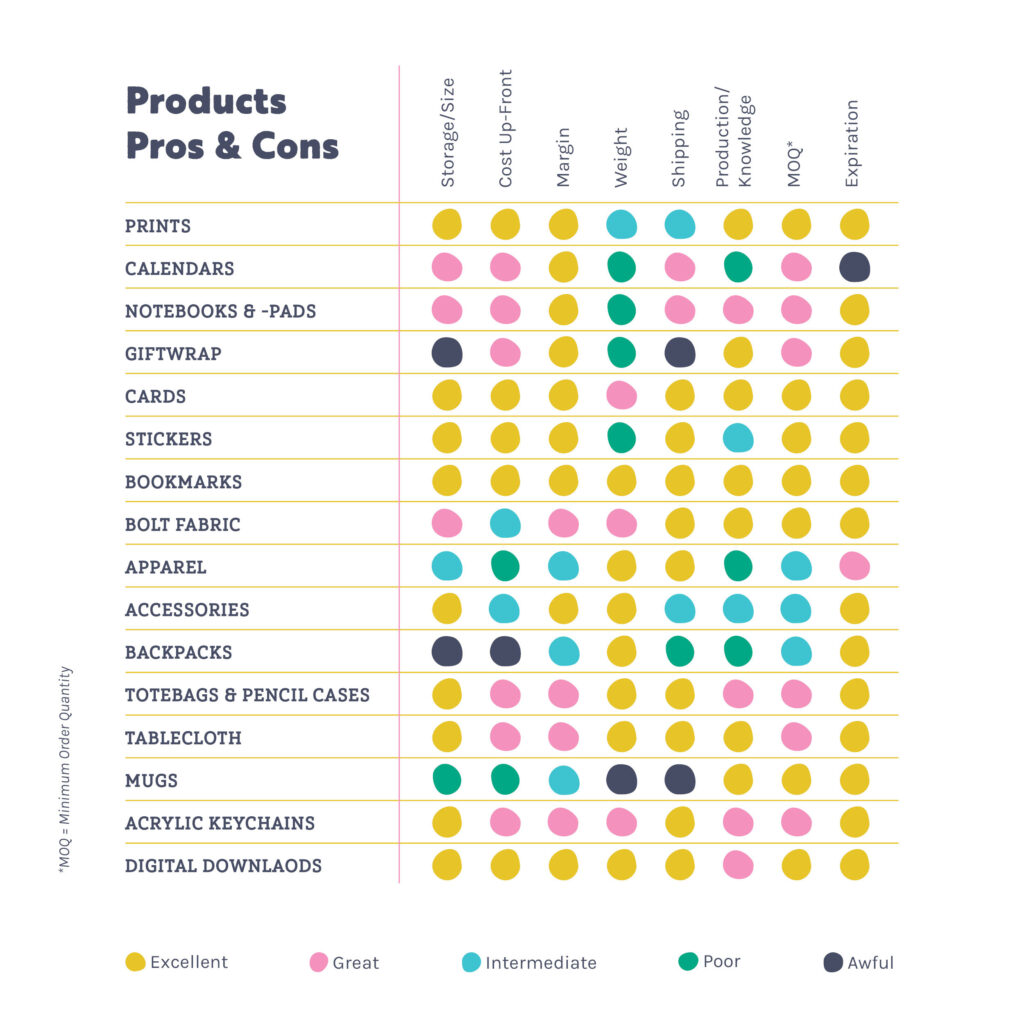
Fabric-based products
I love products made of fabric. It’s the tactile feeling of running your fingers over different kinds of textures. Fabrics can be easier to store because you can fold them down to a smaller size. They also last longer than paper products and can be reused and washed over time.
But investing in your own fabric products can get pricey quite quickly. Depending on where you order, you might have to purchase a certain minimum amount (MOQ = minimum order quantity).
Fabric is a very flexible material, which makes it a versatile choice for a lot of products. For example: bolt fabric, apparel, baby blankets, backpacks, tote bags, pencil cases, wall art and home décor like bedding, kitchenware, cushions, furniture, and upholstery. You could even make covers for books to prevent them from getting damaged or dirty.
Fabric-based products can be folded, but tend to use up more storage space, depending on your order quantities. This is especially true for apparel and the up-front costs are high because you need to order every piece in multiple sizes to cater to your clients.
And because there are so many different types of fabrics out there, ordering just one is likely not enough to create different kinds of products. You will need to order the same design on multiple fabrics to offer your customers the same design on a range of products.
Choosing the right fabric might be overwhelming if you have no prior textile knowledge. Some choices to consider are: natural vs. synthetic fibers, woven vs. knit, grammage, printing method, or if your fabric needs to be certified (necessary for some baby products!).
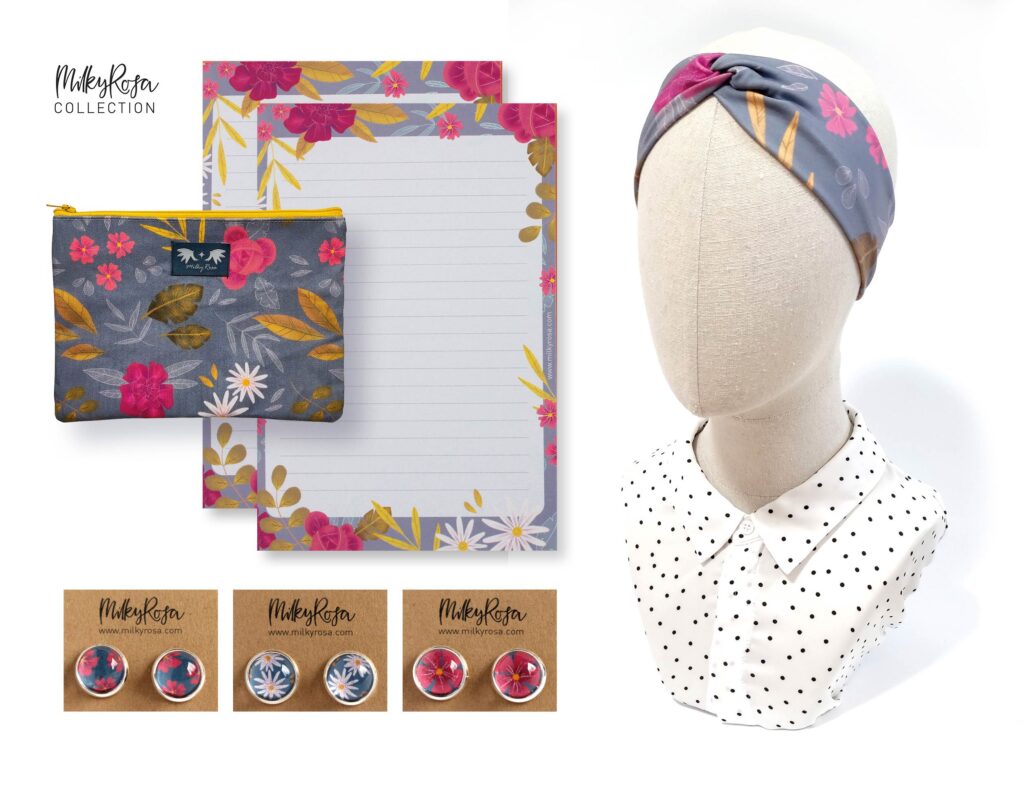
Other products
Of course you can make products from any material. The sky is the limit! I have a friend who has her own laser engraving machine and transfers her illustrations onto wood for keepsake boxes and keychains. Other materials you might want to consider are ceramic, wood, stone, plastics, metal or glass for tableware, mugs, wall art, home décor, keychains, seasonal decorations, or jewelry.
Whatever you decide to make, be sure you do your research before jumping into any decisions, whether it be on the type of product to create or the design you want to use for it. Over the years you’ll grow and evolve and you might even change your assortment over time. And that’s ok!
I started out selling mostly prints and postcards. It was the most cost-effective choice for my small business. When I introduced pencil cases to my customers, my paper products were almost left untouched, because my clients just preferred useful everyday items. Even though prints are a low-risk item, I made a loss due to unsold stock. Now almost all of my products are mid to high-risk, but they sell much better and at a higher price. It just comes down to trial and error and getting to know your target audience.
Tip: If you ever have any stock that doesn’t sell as well as planned — you can turn them into lucky bags! People love a bit of a gamble and you’ll be able to still sell your products.
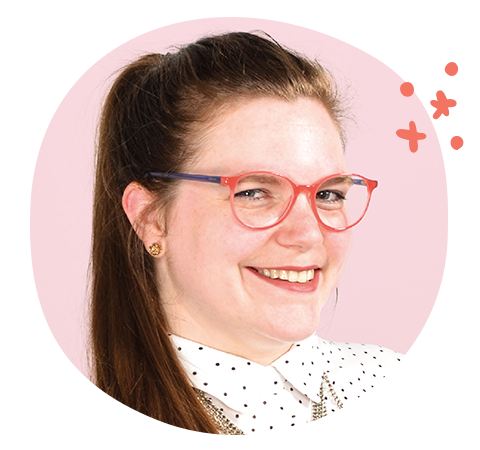
Written by Nina Schindlinger
Website: www.milkyrosa.com
Instagram: @milkyrosadesignagency
Class: Create Your First Product
Nina is the founder and creative director of MilkyRosa Design Agency. She specialises in branding and product design for companies that are young at heart. Her design style is bold, playful and charming, which she uses for her own line of products to make the world a fun and colourful place.